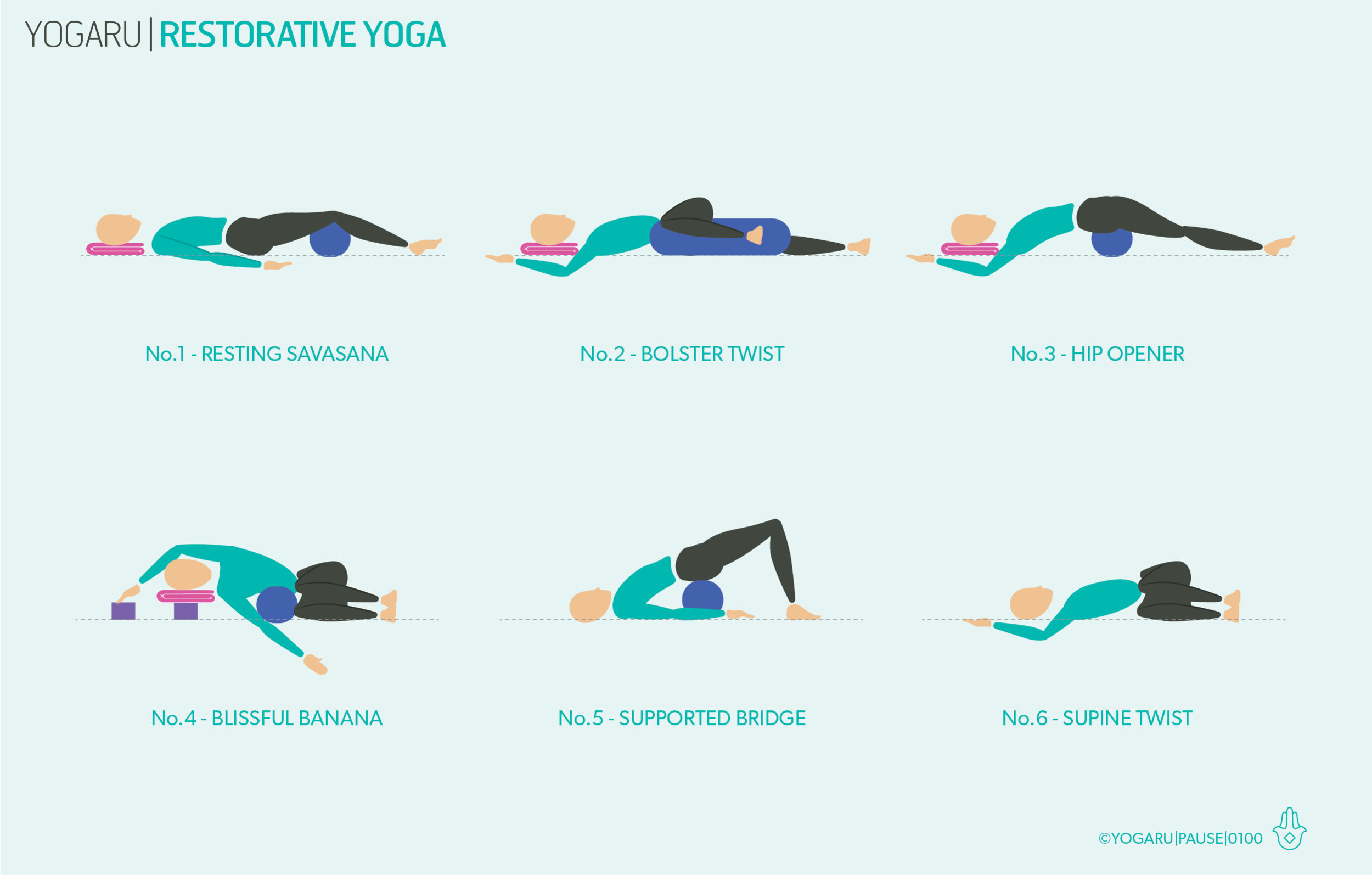THE NERVOUS SYSTEM
Restorative yoga is referred to as ‘the art of accomplishing absolutely nothing but relaxation’. We are so consumed by the idea of constant busyness that doing nothing has become alien to us. Sometimes allowing ourselves to do nothing, and scheduling this ‘nothing’ into our day, is absolutely essential for finding life balance. Another lovely way to think of restorative yoga is ‘our body sleeps and our mind watches’. Although you might find you occasionally drift off to sleep, to get the best out of your practice the aim is to stay awake by observing the resting body. It is an accumulative practice – over the course of your time on the mat you very gradually start to notice spaces between the chatter of the mind, and glimpses of stillness and peace.
Restorative yoga is beneficial for everybody, particularly if that body has been through recent challenges, physical and mental. One of the main benefits of yoga, restorative yoga in particular, is that through the nervous system it strengthens the immune system. It does this with the breath, which stimulates the vagus nerve, bringing the body into the rest, digest and restore response, or the parasympathetic nervous system. This creates optimal conditions for the functionality of the organs of the body and strengthens the immune system and relieves symptoms of chronic stress, fatigue and tension.
Have you ever wondered why you sometimes sigh when faced with an ominous task. The body is a problem solver, it does its best to help us process internal and external stimuli. Essentially a sigh is a long and audible exhale – the exhale is a powerful antidote to life’s obstacles. Consciously slowing the breath and lengthening the exhale in restorative yoga slows the heart rate and stimulates the all important vagus nerve.
EXPLORING THE SEQUENCE
Set yourself up with all you will need, and more, before you get started (see the list of props below). The body will cool down quickly so layer up and stay warm. Unlike regular yoga this is a socks on, stay cosy, practice! The poses are created to give you complete support but we are all very different. Adjust to find complete comfort in each pose using extra blankets and cushions as required. You will be holding the poses for between 5 to 10 minutes so scan down from head to toe and ensure every part of your body is happy. If after a few minutes you start to feel discomfort move to find comfort again. You are the boss of your practice!
Before you move out of a pose think about the idea of moving first, maybe even work out what would be the kindest and gentlest way to move to the next pose. Thread the poses together with gentle awareness to maximise the benefits of your time on your mat. You can use your phone to time when you need to move to the next pose, or you can use your instinct if you don’t like the idea of being disturbed with a sound. If you choose to use your phone set the alert to a soothing sound like ‘chime’ or ‘pulse’.
PROPS ARE KING
Props are king in restorative yoga, the more the merrier! You don’t need to have an array of official yoga props. You can improvise with household items that can do just as good a job. The props you’ll need for these restorative poses are – a bolster, or use two stacked cushions; two yoga bricks, or two thick dictionaries; two to four yoga blankets, or regular blankets.
START WITH THE BREATH
Start your practice in Resting Savasana with your knees resting on a bolster and a blankets over you. Place your hands on your belly and feel the breath move through you. Take four to five rounds of Viloma breath – inhale for a long breath, and then exhale pause, exhale pause, exhale pause – dividing your exhale into three sections. Keep the breath as gentle as possible, notice if you are holding any tension in your shoulders and upper chest when you concentrate on the breath. Pause after your rounds and observe any change to your body and mind. As gravity and the weight of your body draws you down to the ground feel the ground come up to support you as you melt into your practice.
Below are six Restorative Yoga poses for you to choose from. Pick as many or as few as you’d like to practice. You will feel the profound benefits of any amount of restorative yoga added to your day. If you have time for a longer practice consider moving the spine in all directions - forward, back & twist for a well rounded practice.
ALIGNMENT CUES
Below are the restorative techniques used in this sequence.. The props you’ll need are:
1 x bolster - or 2 towels, wrapped around a horizontally rolled pillow and tied to secure.
2 x yoga bricks - or 2 two thick similar sized dictionaries.
2 x yoga blankets - or any wool, thick cotton or fleece blanket with density.
No.1 - Resting savasana
Start lying on your back with a folded blanket under your head, a bolster under the creases of your knees and a blanket over you. Legs and arms extended, palms facing up, lift your buttocks and slide the flesh of the buttocks downwards. Feet gently flop out to the sides. Shoulders melt to the floor. Eyeballs become heavy in their sockets, skin on the forehead smooth as silk. Soften the temples and find ease in the tiny lines around the eyes.
No.2 - Bolster twist
Place your bolster vertically along the left side of the middle of your mat. From lying, with a blanket under your head, extended both legs out along the mat and roll your hips to your left, bend your right knee and place it on the support of the bolster, left leg remains extended. To feel this twist let your upper body and right shoulders settle down onto the mat. Bring your arms to cactus position, with arms lifted and elbows bent either side of the body, gaze over your right shoulder. If the twist is too intense add a folder blanket under your knee on the bolster. If the raised arms doesn’t suit you bring your arms either side of the body palms facing up. Repeat of the left side.
No.3 - Hip opener
From lying, with a blanket under your head, lift your hips up and place the bolster horizontally under the creases of your hips. Lengthen your legs out straight and bring your arms to cactus position, with arms lifted and elbows bent either side of the body. If this is too intense on the lower back, use a rolled up blanket instead of the bolster. If the raised arms doesn’t suit you, bring your arms either side of the body palms facing up.
No.4 - Blissful banana
Make a pillow with a brick and a blanket on top of it at the top of the mat, place an additional brick above this at arms reach. Place your bolster horizontally on your mat with a space between your bolster and pillow. Sit with your right hip next to the long edge of the bolster, knees bent. Lengthen the spine along the mat and nestle the bolster into the curve of your waist. Place your head on your pillow, your shoulder in the space between your props and extend your right arm forward. Extend your left arm overhead and place it on the brick. If the raised arms doesn’t suit you bring your arm down and place it on your right arm. Repeat on the left side.
No.5 - Supported bridge
From lying, lift your hips up and place the bolster horizontally under your hips. Settle your hips down onto the support of the bolster. Knees bent, feet hip distance apart or feet mat distance and knees together. Arms extended either side of your body, palms facing up.
No.6 - Supine twist
From lying on your back bend your knees and place your feet hip distance apart. Gently let your knees drop to the left side of your mat. Extend your right knee away from your. Bring your arms to cactus position, with arms lifted and elbows bent either side of the body, gaze over your right shoulder. Stay here for 5 deep breaths and swap to the other side. If the raised arms doesn’t suit you bring your arms either side of the body, palms facing up.
End your practice with at least 10 minutes of Resting Savasana. Bring your attention to the breath again, as you inhale think ‘this is me now’, and on your exhale tell yourself ‘this is the same me in the outside world’.
To save the images for personal use click and hold down the image until the ‘save image’ option appears; on Mac hold down ‘control’ and click the image to get the option box; on PC right click on the image to get the option box. Scroll down in the ‘option box’ and click ‘save image’.
Ruth Delahunty Yogaru




